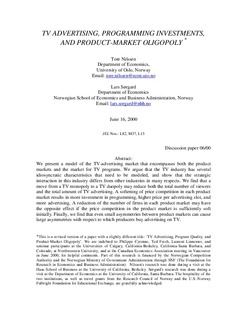| dc.contributor.author | Nilssen, Tore | |
| dc.contributor.author | Sørgard, Lars | |
| dc.date.accessioned | 2006-08-16T07:17:28Z | |
| dc.date.available | 2006-08-16T07:17:28Z | |
| dc.date.issued | 2000-06 | |
| dc.identifier.issn | 0804-6824 | |
| dc.identifier.uri | http://hdl.handle.net/11250/162992 | |
| dc.description.abstract | We present a model of the TV-advertising market that encompasses both the product
markets and the market for TV programs. We argue that the TV industry has several
idiosyncratic characteristics that need to be modeled, and show that the strategic
interaction in this industry differs from other industries in many respects. We find that a
move from a TV monopoly to a TV duopoly may reduce both the total number of viewers
and the total amount of TV advertising. A softening of price competition in each product
market results in more investment in programming, higher price per advertising slot, and
more advertising. A reduction of the number of firms in each product market may have
the opposite effect if the price competition in the product market is sufficiently soft
initially. Finally, we find that even small asymmetries between product markets can cause large asymmetries with respect to which producers buy advertising on TV. | en |
| dc.format.extent | 166966 bytes | |
| dc.format.mimetype | application/pdf | |
| dc.language.iso | eng | en |
| dc.publisher | Norwegian School of Economics and Business Administration. Department of Economics | en |
| dc.relation.ispartofseries | Discussion paper | en |
| dc.relation.ispartofseries | 2000:6 | en |
| dc.title | TV advertising, programming investments, and product-market oligopoly | en |
| dc.type | Working paper | en |
